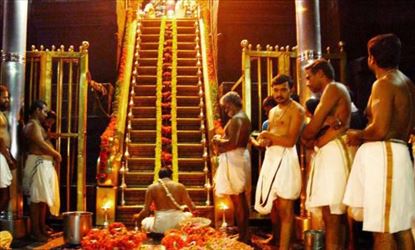
The first five steps symbolize the five human senses (Panchendriyas) i.e. visual (vision), auditory (hearing), olfactory (smell), gustatory (taste) and tactile (touch). These signify the `mortal’ nature of one’s body. The next eight steps symbolise the eight Ashtaragas viz, Kama, Krodha, Lobha, Moha, Madha, Maltsarya, Asooya, Dhumb (Love, Anger, Avarice, Lust, Pride, Unhealthy Competition, Jealousy and Boastfulness). The next three steps stand for three Gunas or Thrigunas (nature-born qualities) i.e. Satva, (perspicuity, discernment) , Rajas (activity, enjoyment) and Thamas (inactivity, stupor). The last two steps represent Vidya (Knowledge) and Avidya (Ignorance).
It is assumed that after climbing up these eighteen steps reverently, one symbolically detaches oneself from all the worldly ties that bind one physically and mentally to the world. It is only then that a person will be in a receptive condition to be ‘one’ in consonance with the concept of ‘The Ultimate Creator’.

The above are the most prevalent accepted version of the significance of the Holy 18 steps. Other versions are as follows: Ayyappa was a master of 18 weapons and the steps signify these. Ayyappa before merging into the idol at the Sanctum Sanctorum, surrendered his 18 weapons, one at each step of Pathinettam Padi.




